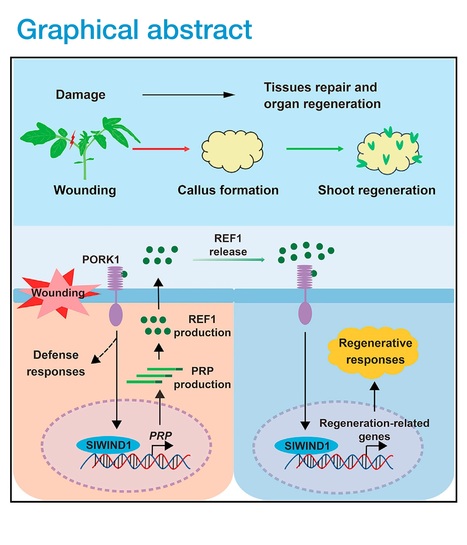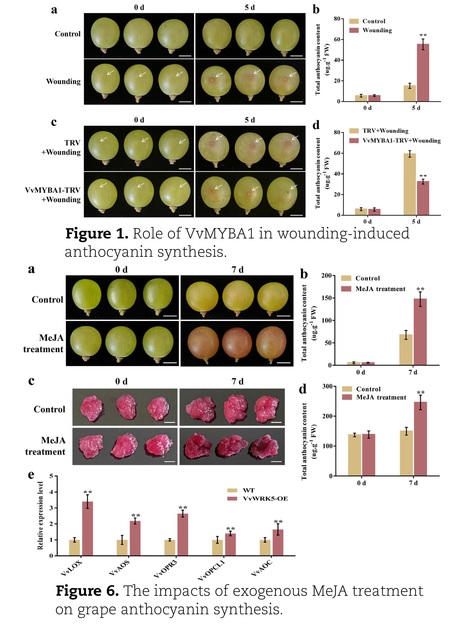 Your new post is loading...
 Your new post is loading...
Authors: Wentao Yang, Huawei Zhai, Fangming Wu, Lei Deng, Yu Chao, Xianwen Meng, Qian Chen, Chenhuan Liu, Xiaomin Bie, Chuanlong Sun, Yang Yu, Xiaofei Zhang, Xiaoyue Zhang, Zeqian Chang, Min Xue, Yajie Zhao, Xiangbing Meng, Boshu Li, Xiansheng Zhang, Dajian Zhang, Xiangyu Zhao, Caixia Gao, Jiayang Li and Chuanyou Li.
Cell (2024)
Editor's view: REF1 is a systemin-independent local wound signal that promotes regenerative responses, and the application of REF1 enhances the transformation efficiency of recalcitrant crops by boosting their regeneration capacity.
Highlights: • REF1 is a systemin-independent local wound signal promoting regenerative responses • REF1 is perceived by the receptor PORK1 for plant regeneration • REF1-PORK1 promotes regeneration via activating the master transcription factor WIND1 • REF1 offers a simple method to boost the regeneration efficiency of recalcitrant crops
Abstract: "Plants frequently encounter wounding and have evolved an extraordinary regenerative capacity to heal the wounds. However, the wound signal that triggers regenerative responses has not been identified. Here, through characterization of a tomato mutant defective in both wound-induced defense and regeneration, we demonstrate that in tomato, a plant elicitor peptide (Pep), REGENERATION FACTOR1 (REF1), acts as a systemin-independent local wound signal that primarily regulates local defense responses and regenerative responses in response to wounding. We further identified PEPR1/2 ORTHOLOG RECEPTOR-LIKE KINASE1 (PORK1) as the receptor perceiving REF1 signal for plant regeneration. REF1-PORK1-mediated signaling promotes regeneration via activating WOUND-INDUCED DEDIFFERENTIATION 1 (WIND1), a master regulator of wound-induced cellular reprogramming in plants. Thus, REF1-PORK1 signaling represents a conserved phytocytokine pathway to initiate, amplify, and stabilize a signaling cascade that orchestrates wound-triggered organ regeneration. Application of REF1 provides a simple method to boost the regeneration and transformation efficiency of recalcitrant crops.
Authors: Jinquan Chao, Shaohua Wu, Minjing Shi, Xia Xu, Qiang Gao, Huilong Du, Bin Gao, Dong Guo, Shuguang Yang, Shixin Zhang, Yan Li, Xiuli Fan, Chunyan Hai, Liquan Kou, Jiao Zhang, Zhiwei Wang, Yan Li, Wenbo Xue, Jiang Xu, Xiaomin Deng, Xiao Huang, Xinsheng Gao, Xiaofei Zhang, Yanshi Hu, Xia Zeng, Weiguo Li, Liangsheng Zhang, Shiqing Peng, Jilin Wu, Bingzhong Hao, Xuchu Wang, Hong Yu, Jiayang Li, Chengzhi Liang and Wei-Min Tian
Nature Communications (2023)
Editor's view: Understanding the genetic basis of rubber tree domestication is critical for improving natural rubber production. Here, the authors assemble the genome of the rubber tree clone CATAS8-79 and conduct population and genetic association analyses to reveal the function of phytosulfokine in regulating number of laticifer rings.
Understanding the genetic basis of rubber tree (Hevea brasiliensis) domestication is crucial for further improving natural rubber production to meet its increasing demand worldwide. Here we provide a high-quality H. brasiliensis genome assembly (1.58 Gb, contig N50 of 11.21 megabases), present a map of genome variations by resequencing 335 accessions and reveal domestication-related molecular signals and a major domestication trait, the higher number of laticifer rings. We further show that HbPSK5, encoding the small-peptide hormone phytosulfokine (PSK), is a key domestication gene and closely correlated with the major domestication trait. The transcriptional activation of HbPSK5 by myelocytomatosis (MYC) members links PSK signaling to jasmonates in regulating the laticifer differentiation in rubber tree. Heterologous overexpression of HbPSK5 in Russian dandelion (Taraxacum kok-saghyz) can increase rubber content by promoting laticifer formation. Our results provide an insight into target genes for improving rubber tree and accelerating the domestication of other rubber-producing plants."
|
Authors: Zhen Zhang, Cui Chen, Changyue Jiang, Hong Lin, Yuhui Zhao and Yinshan Guo.
Horticulture Research (2024)
Abstract: "Wounding stress induces the biosynthesis of various secondary metabolites in plants, including anthocyanin. However, the underlying molecular mechanism remains elusive. Here, we reported that a transcription factor, VvWRKY5, promotes wounding-induced anthocyanin accumulation in grape (Vitis vinifera). Biochemical and molecular analyses demonstrated that wounding stress significantly increased anthocyanin content, and VvMYBA1 plays an essential role in this process. VvWRKY5 could interact with VvMYBA1 and amplify the activation effect of VvMYBA1 on its target gene VvUFGT. The transcript level of VvWRKY5 was notably induced by wounding treatment. Moreover, our data demonstrated that VvWRKY5 could promote the synthesis of jasmonic acid (JA), a phytohormone that acts as a positive modulator in anthocyanin accumulation, by directly binding to the W-box element in the promoter of the JA biosynthesis-related gene VvLOX and enhancing its activities, and this activation was greatly enhanced by the VvWRKY5-VvMYBA1 protein complex. Collectively, our findings show that VvWRKY5 plays crucial roles in wounding-induced anthocyanin synthesis in grape and elucidates the transcriptional regulatory mechanism of wounding-induced anthocyanin accumulation."
Authors: Ai Zhang, Keita Matsuoka, Abdul Kareem, Madalen Robert, Pawel Roszak, Bernhard Blob, Anchal Bisht, Lieven De Veylder, Cătălin Voiniciuc, Masashi Asahina and Charles W. Melnyk.
Current Biology (2022)
Editor's view: Plants require an efficient regeneration system to heal wounds. Zhang et al. identify four DOF transcription factors that are rapidly activated at sites of wounding, graft formation, or tissue cutting. These DOFs are activated by cell-wall damage and auxin to promote tissue regeneration and wound healing.
Highlights: • Four DOF transcription factors are rapidly activated at wounding and grafting sites • Damage to or modifications of the cellulose and pectin matrix activate DOFs • DOFs regulate callus formation, tissue adhesion, and vascular regeneration at wounds • Wound-associated ERF115 and ANAC096 are also activated upon cell-wall damage
Abstract: "Wound healing is a fundamental property of plants and animals that requires recognition of cellular damage to initiate regeneration. In plants, wounding activates a defense response via the production of jasmonic acid and a regeneration response via the hormone auxin and several ethylene response factor (ERF) and NAC domain-containing protein (ANAC) transcription factors. To better understand how plants recognize damage and initiate healing, we searched for factors upregulated during the horticulturally relevant process of plant grafting and found four related DNA binding with one finger (DOF) transcription factors, HIGH CAMBIAL ACTIVITY2 (HCA2), TARGET OF MONOPTEROS6 (TMO6), DOF2.1, and DOF6, whose expression rapidly activated at the Arabidopsis graft junction. Grafting or wounding a quadruple hca2, tmo6, dof2.1, dof6 mutant inhibited vascular and cell-wall-related gene expression. Furthermore, the quadruple dof mutant reduced callus formation, tissue attachment, vascular regeneration, and pectin methylesterification in response to wounding. We also found that activation of DOF gene expression after wounding required auxin, but hormone treatment alone was insufficient for their induction. However, modifying cell walls by enzymatic digestion of cellulose or pectin greatly enhanced TMO6 and HCA2 expression, whereas genetic modifications to the pectin or cellulose matrix using the PECTIN METHYLESTERASE INHIBITOR5 overexpression line or korrigan1 mutant altered TMO6 and HCA2 expression. Changes to the cellulose or pectin matrix were also sufficient to activate the wound-associated ERF115 and ANAC096 transcription factors, suggesting that cell-wall damage represents a common mechanism for wound perception and the promotion of tissue regeneration."
|




 Your new post is loading...
Your new post is loading...









